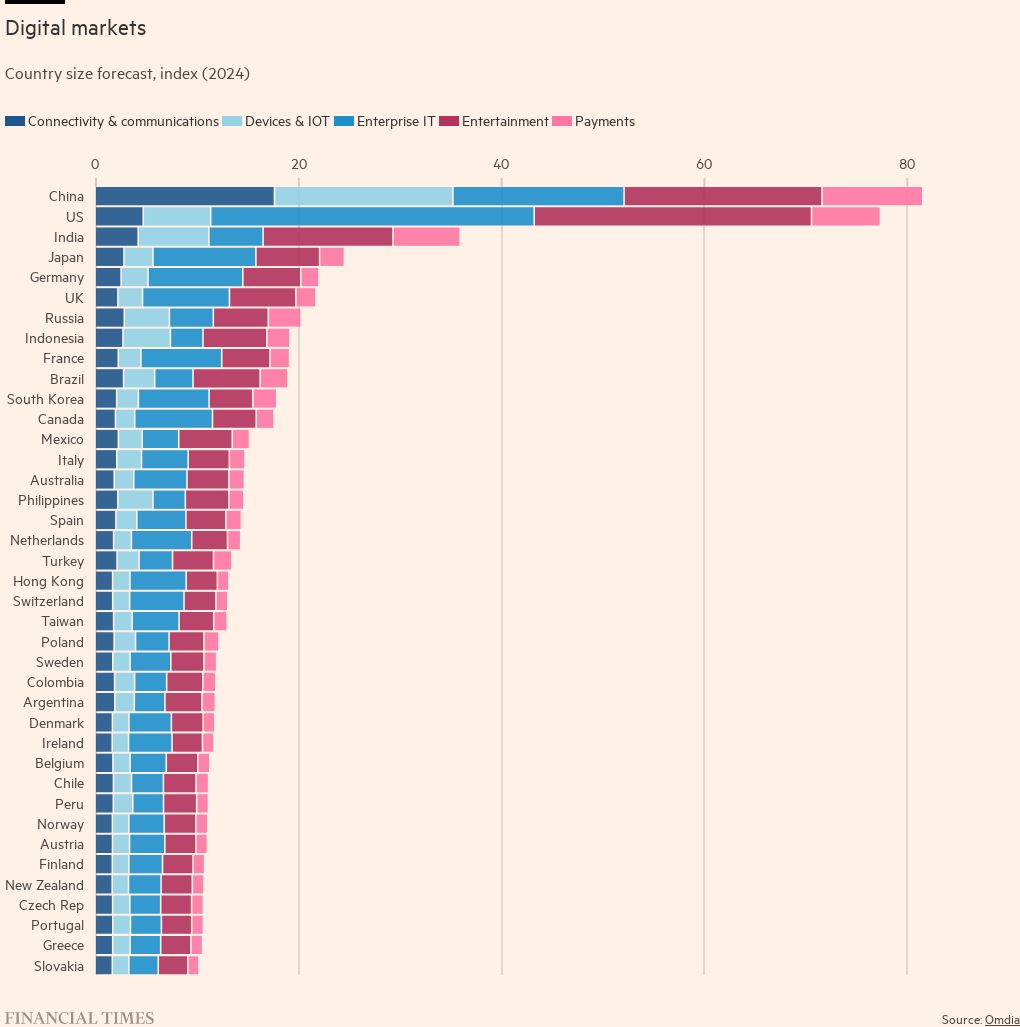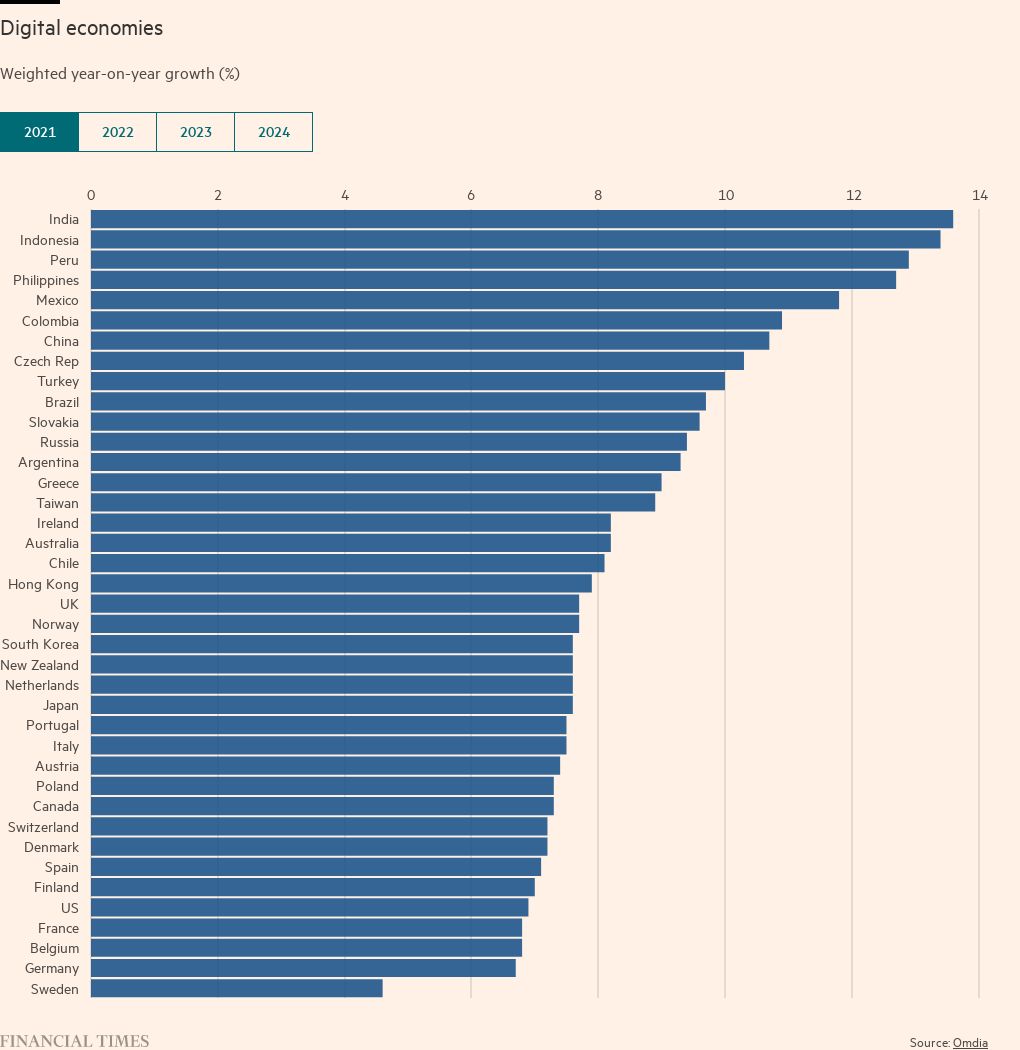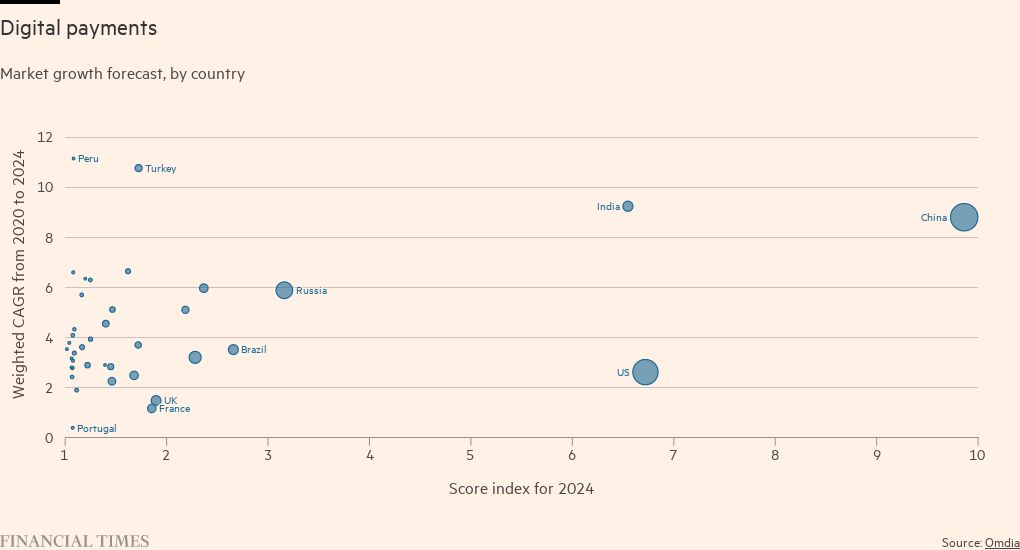FT-Omdia Digital Economies Index: spotting the next tech growth markets

Roula Khalaf, Editor of the FT, selects her favourite stories in this weekly newsletter.
Smartphones are owned by 85 per cent of all adults in the US, and 92 per cent of all adults in the UK, according to research by Statista. So, which countries still offer growth potential for handset makers and telecoms networks?
Meanwhile, payment card numbers in the EU have risen to 609m, based on the latest European Central Bank data, which means each person in the bloc holds an average of 1.8 cards. So, where can neobanks and fintechs find new payment customers?
It is to answer questions such as these that the FT-Omdia Digital Economies Index was compiled. It uses a range of data sources to measure advances in five areas of digital product and service consumption worldwide. And from this data, it can calculate the national technology markets that are growing the fastest overall, as well as the markets offering the greatest scope for growth for particular industry sectors — from smartphones to payment cards, from streaming video to enterprise software.
These are the five areas of the digital economy that the FT-Omdia index assesses, using 16 performance measures across 39 countries:
Connectivity — the ability to connect and communicate with digital services, through fixed and mobile broadband connections;
Devices — access to smart devices to consume digital services, including smartphones, notebooks and tablets, and cellular “internet of things” equipment;
Entertainment — the availability of digital entertainment services, including video and music streaming services, Facebook, and YouTube;
Payments — the ability to pay digitally, the number of cardholders, and the debit cards in issue;
Enterprise software and cloud computing — information and communication technology spend, cloud spend and adoption.
By allocating scores based on these measures and their growth rates, the index can calculate the size of a country’s digital economy and forecast how it will change by 2024. Here are the initial findings.
The largest digital economies
In 2022, China will overtake the US to become the largest digital economy in the world, based on the inaugural numbers from the FT-Omdia index. This pivotal moment is the result of China’s sustained infrastructure investment over the past five years — in particular, in 5G connectivity and fibre cabling. In the past 12 months alone, China has added a total of 257m 5G connections and 43.85m fibre connections, compared with 58m and 2.19m, respectively, in the US, according to Omdia analysts.
In addition, China has been investing heavily in industrial automation via cellular IoT equipment. Omdia forecasts that the installed base of cellular IoT connections in the country will grow from 1.1bn in 2020 to 1.7bn by 2024. To put that in context, Germany will reach 45m IoT cellular connections in 2024, up from 36m in 2020.
In comparison, the US has trailed China in broad technology investment, and still lags other parts of the world in its adoption of new systems — for example, payment cards. However, the US maintains the second spot on the index to 2024, with strength in digital entertainment markets and enterprise software.
The fastest-growing digital economies
In the years to 2024, India, Peru, Indonesia, the Philippines and Mexico will be the five fastest-growing digital economies, based on the sectors covered by the FT-Omdia Index.
What all of these markets have in common is a rapidly growing proportion of middle-class consumers, with the income to access digital platforms, plus the necessary technology infrastructure in place. In some cases, the digital infrastructure is equivalent to that in more developed economies.
India is forecast to have the fastest-growing digital economy of all, with a compound annual growth rate (CAGR) of 8.8 per cent over the period 2020-2024. Performance will be particularly strong in the entertainment market, with a CAGR of 15 per cent expected, driven by growth in entertainment including video and music subscriptions, online advertising revenue, and YouTube and Facebook active users. India will also grow its enterprise IT market, where it is forecast to see a CAGR of 14 per cent.
Peru is expected to be the second fastest growing digital economy, with a CAGR of 7.6 per cent through to 2024, largely thanks to a double-digit increase in the devices and IoT market. It is also forecast to outperform in digital payments.
Indonesia’s digital growth, meanwhile, will be powered by international services and the rapid adoption of mobile messaging and mobile gaming. The Philippines scores highly for growing internet penetration, which is bringing more social media use and video consumption. Mexico makes the top five for digital growth by outperforming in music subscriptions, Facebook use and YouTube viewing.
The next tech growth markets
To discover which of these and other national markets are forecast to grow fastest in the five main areas covered by the index, read on:
Connectivity — Full fibre broadband fuels investor appetite for fixed line
Devices — 5G rollouts offer ‘internet of things’ a more sophisticated outlook
Entertainment — Online streaming looks to Asia for steady flow of subscribers
Payments — Emerging markets ‘leapfrog’ the west in digital payments race
Enterprise software and cloud computing — Digital demand sets cloud adoption on course for next stage
More details of the FT-Omdia Digital Economies Index are available on the Omdia web portal.



Comments